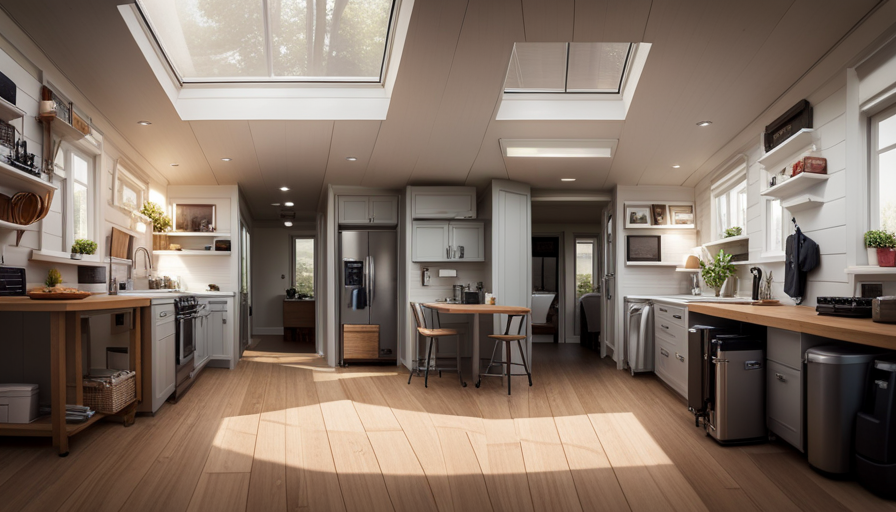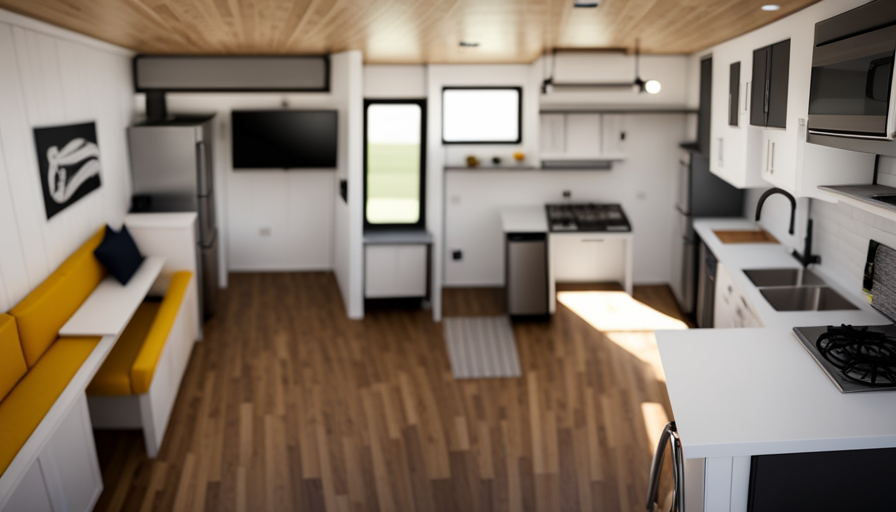It might surprise you how much weight a small space can hold. Seriously, who would’ve imagined that a tiny house measuring 8×20 could weigh so much? It’s like discovering a secret treasure trove, bursting with mysteries and unexpected delights.
But before you start envisioning a magical wonderland, it’s important to understand the practical implications of all that weight. From transportation challenges to foundation considerations, the weight of a tiny house can have a significant impact on its mobility and longevity.
In this article, we’ll delve into the dimensions of an 8×20 tiny house, explore the factors that contribute to its weight, and discuss strategies for reducing that weight. So, if you’re ready to lift the veil on the mysteries of tiny house weight, let’s get started!
Key Takeaways
- The weight of an 8×20 tiny house can impact mobility and longevity.
- Factors contributing to weight include size, materials, and structural design.
- Lightweight materials like aluminum or fiberglass can reduce weight.
- Proper weight distribution ensures structural integrity and safe towing.
Understanding the Dimensions of an 8×20 Tiny House
So, you’re probably wondering just how heavy an 8×20 tiny house actually is. Well, let me break it down for you.
The weight of a tiny house is influenced by several factors, including its size, materials used, and the structural design. When it comes to an 8×20 tiny house, the dimensions alone play a significant role in determining its weight. The larger the house, the more materials are needed, which ultimately adds to its overall weight.
Another factor that affects the weight of a tiny house is the choice of materials. For example, if the house is constructed using lightweight materials such as aluminum or fiberglass, it’ll be lighter compared to a house made of heavier materials like wood or steel.
The structural design of the house also plays a crucial role in its weight. A well-designed house with appropriate support and framing can distribute the weight evenly, making it more stable and easier to move.
It’s important to consider the impact of weight on the mobility of a tiny house. A heavier house may require a larger towing vehicle or even a professional transportation service to move it. Additionally, weight affects the overall stability of the house, especially when it needs to be transported over uneven terrains or during strong winds.
Now that we understand the dimensions of an 8×20 tiny house and the factors affecting its weight, let’s dive deeper into the factors that contribute to the weight of a tiny house.
Factors That Contribute to the Weight of a Tiny House
To calculate the weight of your 8×20 tiny house, you’ll need to consider various factors that contribute to its overall mass. These factors include the materials used, furniture inside, and the appliances you choose.
These factors are crucial in determining how heavy your tiny house will be and how it will distribute its weight.
Firstly, the materials used in construction play a significant role in the overall weight of the tiny house. For example, using lightweight materials such as aluminum or composite panels can help reduce the weight significantly compared to traditional building materials like wood or concrete.
Secondly, the furniture and appliances you choose to include in your tiny house will also contribute to its weight. Remember to consider the weight of items such as beds, tables, chairs, and kitchen appliances when planning your tiny house layout.
Lastly, weight distribution is another important factor to consider. Properly distributing the weight of your tiny house ensures structural integrity and safe towing. Placing heavier items near the center of the house and evenly distributing the weight throughout the floor will help maintain balance and stability.
Considering these factors will give you a better understanding of how heavy your 8×20 tiny house will be.
In the next section, we will explore the average weight range for an 8×20 tiny house and provide further insights into this topic.
The Average Weight Range for an 8×20 Tiny House
When you think about an 8×20 tiny house, imagine a compact living space that fits all your essentials while remaining light and mobile. The average weight of an 8×20 tiny house ranges from 10,000 to 12,000 pounds. This weight includes the structural components, interior fixtures, appliances, and personal belongings.
Here are four factors that contribute to the average weight range of an 8×20 tiny house:
-
Building materials: The materials used in the construction of the tiny house can greatly affect its weight. For example, using heavier materials like wood or metal will increase the overall weight.
-
Interior design choices: The weight of appliances, furniture, and other interior fixtures can add up quickly. Opting for lightweight options can help keep the overall weight down.
-
Insulation and roofing: A well-insulated and sturdy roof is essential for a tiny house, but it also adds to the weight. Choosing lightweight insulation materials and roofing options can help balance the weight.
-
Size dimensions: The larger the tiny house, the more materials it will require, resulting in a higher weight. An 8×20 tiny house is relatively small compared to other sizes, so it falls within the average weight range.
Considering the average weight of an 8×20 tiny house is crucial when planning for transportation and mobility.
How Weight Impacts Transportation and Mobility
Imagine the exhilaration of effortlessly navigating the open road with your compact living space, as the weight of your mobile sanctuary impacts its transportation and mobility. Understanding weight distribution is crucial for ensuring transportation safety when it comes to tiny houses. The weight of the house needs to be evenly distributed to prevent any imbalance that could lead to accidents on the road.
Additionally, the weight of the tiny house affects its mobility. A heavier house may require a more powerful vehicle to tow it and can limit the places you can take it.
When it comes to transportation safety, it’s important to consider the weight of your tiny house along with the weight capacity of your towing vehicle. Exceeding the weight limit can put unnecessary strain on the vehicle, potentially causing damage or even accidents. It’s essential to consult with professionals who can assess the weight distribution and provide guidance on the appropriate towing vehicle and equipment.
Reducing the weight of a tiny house can provide more flexibility in transportation and mobility. In the next section, we’ll explore strategies for achieving a lighter tiny house without compromising its functionality or structural integrity.
Strategies for Reducing the Weight of a Tiny House
By implementing various weight-reduction strategies, you can create a lighter, more mobile living space for your tiny home. When building a tiny house, every pound matters. The lighter your house is, the easier it’ll be to tow and transport.
So, let’s talk about some effective strategies for reducing the weight of your tiny house.
First, consider using lightweight construction materials. Opt for materials like aluminum or composite panels instead of traditional lumber. These materials aren’t only lighter but also offer excellent durability.
Next, think about the design of your tiny house. Keep the structure simple and avoid unnecessary additions that add weight. Optimize the layout to maximize space utilization while keeping the weight to a minimum.
Another strategy is to be mindful of your appliances and fixtures. Choose energy-efficient and lightweight options. Look for compact appliances that are specifically designed for small spaces.
Lastly, don’t forget about the weight of your belongings. Be selective when it comes to your furniture and personal items. Minimize clutter and only keep what you truly need.
By implementing these weight-reduction strategies, you can create a tiny house that’s easier to move and transport.
Now, let’s discuss the importance of proper weight distribution in ensuring a safe and stable towing experience.
The Importance of Proper Weight Distribution
Ensuring proper weight distribution is crucial for a secure and balanced towing experience, guaranteeing the safety and stability of your mobile living space. Proper weight distribution not only impacts the towing experience but also has a significant effect on the overall mobility of your tiny house. By distributing the weight appropriately, you can avoid issues such as swaying, fishtailing, and uneven tire wear.
To understand the importance of proper weight distribution, let’s take a look at the following table:
| Area of the Tiny House | Recommended Weight Distribution |
|---|---|
| Front | 10-15% of the total weight |
| Middle | 60-65% of the total weight |
| Rear | 20-25% of the total weight |
By following these weight distribution guidelines, you can ensure that your tiny house is well-balanced and stable during transportation. The weight on the axles should be evenly distributed to prevent unnecessary stress on certain areas. This will result in a smoother towing experience and reduce the risk of accidents or damage to your tiny house.
With a clear understanding of proper weight distribution, we can now move on to discussing how to safely transport and set up an 8×20 tiny house. This involves considering factors such as route planning, securing the house during transportation, and the necessary preparations for setting up at the destination.
How to Safely Transport and Set Up an 8×20 Tiny House
To safely transport and set up your compact living space, you’ll need to navigate the road like a skilled captain guiding their ship through treacherous waters. Ensuring the safety of your tiny house during transportation and setup requires careful planning and adherence to certain precautions. Here are three essential steps to safely transport and set up an 8×20 tiny house:
-
Safety Precautions: Before hitting the road, it’s crucial to secure all loose items inside your tiny house. This includes fastening furniture, appliances, and other belongings to prevent them from shifting during transportation. Additionally, inspect the exterior for any loose panels or components that could pose a hazard while on the road. Finally, ensure that all connections, such as plumbing and electrical, are properly secured and protected.
-
Professional Assistance: Transporting and setting up an 8×20 tiny house can be a complex task. It’s highly recommended to seek professional assistance from experienced movers who specialize in tiny houses. They possess the knowledge, equipment, and expertise to safely handle the transportation and setup process, minimizing the risk of damage to your valuable investment.
-
Considerations for Foundation and Anchoring Systems: Once your tiny house is safely transported to its destination, the next step is to properly anchor and secure it in place. This involves selecting an appropriate foundation system and following local building codes and regulations. Ensuring a solid foundation and properly anchoring your tiny house will provide stability and help protect it against external forces such as wind and seismic activity.
Transitioning into the subsequent section about considerations for foundation and anchoring systems, it’s crucial to understand the importance of a solid base for your tiny house.
Considerations for Foundation and Anchoring Systems
When choosing the foundation and anchoring systems for your compact living space, it’s essential to prioritize stability and compliance with local regulations.
The foundation considerations for an 8×20 tiny house are crucial as they determine the structural integrity and longevity of your home. One common option is a concrete slab foundation, which provides a solid and level base for your tiny house. However, it’s important to ensure that the slab is thick enough to support the weight of the house and that it’s reinforced with steel for added strength.
Another option is a pier and beam foundation, which involves using concrete piers to support the structure. This allows for better ventilation and easy access to utilities, but it may require more maintenance over time.
Additionally, you’ll need to choose the appropriate anchoring system to secure your tiny house to the foundation. This can include using hurricane straps, ground anchors, or helical piers, depending on your location and local regulations.
Considering these foundation considerations and selecting the right anchoring systems will provide a stable and secure base for your 8×20 tiny house. This ensures that your home can withstand the elements and remain safe and comfortable for years to come.
Moving forward, let’s explore the essential aspects of maintenance and upkeep for a heavy tiny house.
Maintenance and Upkeep for a Heavy Tiny House
You may be thrilled to discover the joys of constantly tending to the never-ending maintenance needs of your compact living abode. Maintaining a heavy tiny house requires dedication and attention to detail. To help you navigate the ins and outs of maintenance, here are some essential tips and common issues to keep in mind.
First and foremost, regular inspections are crucial to catch any potential problems early on. Check for signs of water damage, such as leaks or mold, as well as any structural issues that may arise due to the weight of your tiny house. Additionally, ensure that your foundation and anchoring systems remain intact and secure.
Another important aspect of maintenance is keeping your tiny house clean and well-maintained. Regularly clean the exterior, including the roof, siding, and windows, to prevent dirt and debris buildup. Inspect and maintain the plumbing and electrical systems to ensure they are functioning properly.
To provide you with a visual representation of the maintenance tasks and common issues associated with a heavy tiny house, here is a table showcasing some key aspects:
| Maintenance Task | Common Issue |
|---|---|
| Roof inspection | Leaks and damage |
| Foundation check | Shifting or settling |
| Electrical system | Wiring issues |
| Plumbing inspection | Clogs or leaks |
| Exterior cleaning | Weathering and dirt |
By following these maintenance tips and addressing common issues promptly, you can ensure that your heavy tiny house remains in top shape. Now, let’s explore alternative tiny house options for lightweight living.
Exploring Alternative Tiny House Options for Lightweight Living
Consider the freedom and simplicity of living in a featherweight compact dwelling that effortlessly blends into its natural surroundings. Exploring alternative tiny house options for lightweight living opens up a world of possibilities. By utilizing alternative materials and embracing a minimalist design, homeowners can create a space that’s both functional and environmentally friendly.
Here are three sub-lists that highlight the benefits of alternative materials and minimalist design in lightweight tiny houses:
-
Alternative Materials:
- Incorporating lightweight materials such as bamboo, reclaimed wood, or even recycled plastic can significantly reduce the overall weight of the tiny house.
- Utilizing high-strength, low-weight materials like fiberglass or carbon fiber can provide durability without adding unnecessary pounds.
- Considering modular construction techniques allows for easy assembly and disassembly, making it possible to relocate the tiny house effortlessly.
-
Minimalist Design:
- Adopting a minimalist approach to design ensures that the tiny house remains clutter-free, which not only enhances the sense of space but also reduces unnecessary weight.
- Maximizing natural light through strategically placed windows and skylights can create the illusion of a larger living area while minimizing the need for artificial lighting.
- Incorporating multifunctional furniture and clever storage solutions maximizes the available space and eliminates the need for excess belongings.
By combining alternative materials and minimalist design principles, a lightweight tiny house offers a sustainable and efficient living solution that harmonizes with nature while providing all the necessary comforts of home.
Frequently Asked Questions
What are the different types of foundation and anchoring systems that can be used for a heavy tiny house?
Proper foundation and anchoring are vital for heavy tiny houses, ensuring stability and safety. There are several types of foundation and anchoring systems available, each serving a specific purpose.
Some options include concrete slab foundations, pier and beam foundations, and helical pile anchoring systems. The choice depends on factors such as soil conditions, local building codes, and the weight of the tiny house.
It’s crucial to select the right system to ensure the structural integrity of your heavy tiny house.
Are there any maintenance and upkeep requirements specifically for heavy tiny houses?
Maintenance requirements for heavy tiny houses include regular inspections of the foundation and anchoring systems. It’s crucial to ensure that all components are in good condition and properly secured to withstand the weight of the structure. Additionally, durability considerations should be taken into account when choosing materials and construction methods. This includes selecting weather-resistant materials and implementing proper insulation to prevent damage from moisture and temperature fluctuations. Regular cleaning and upkeep of the exterior and interior are also essential for long-term durability.
What are some alternative tiny house options that are designed for lightweight living?
Looking for a tiny house that won’t weigh you down? Well, you’re in luck! There are plenty of alternative options out there designed for lightweight living.
By using lightweight materials and compact design, these tiny houses offer the perfect solution for those who want to minimize their environmental footprint without sacrificing comfort.
From modular homes to eco-friendly pods, the possibilities are endless. So, if you’re ready to embrace a lighter lifestyle, these lightweight tiny houses are definitely worth considering.
How does weight impact the mobility and transportation of an 8×20 tiny house?
The weight of an 8×20 tiny house has a significant impact on its mobility and transportation. The towing capacity of a vehicle is directly affected by the weight of the tiny house, so it’s crucial to consider this when planning to move it. Factors such as the type of trailer, axle capacity, and weight distribution play a role in determining the feasibility of transporting a heavy tiny house.
It’s important to consult with professionals and ensure that all safety guidelines are followed during transportation.
Can you provide some strategies for reducing the weight of a tiny house without compromising its structural integrity?
Reducing weight in a tiny house is crucial to ensure both mobility and structural integrity. There are several strategies to achieve this.
Firstly, opting for lightweight building materials like composite panels or steel frames can significantly decrease overall weight.
Secondly, designing with open floor plans and minimalistic features minimizes unnecessary weight.
Lastly, using innovative space-saving solutions and efficient insulation techniques can further reduce weight without compromising the structural integrity of the tiny house.
Conclusion
In conclusion, when it comes to the weight of an 8×20 tiny house, there are various factors to consider. From the materials used to the design choices made, every decision impacts the overall weight.
It’s important to keep in mind that a heavy tiny house can pose challenges when it comes to transportation and mobility. However, by implementing strategies to reduce weight and carefully planning the setup process, it is possible to overcome these obstacles.
So, whether you opt for a heavy or a lightweight tiny house, the choice is yours to make based on your specific needs and preferences.
Hi, I’m Emma. I’m the Editor in Chief of Tiny House 43, a blog all about tiny houses. While tree houses are often associated with childhood, they can be the perfect adult retreat. They offer a cozy space to relax and unwind, surrounded by nature. And since they’re typically built on stilts or raised platforms, they offer stunning views that traditional homes simply can’t match. If you’re looking for a unique and romantic getaway, a tree house tiny house might just be the perfect option.










